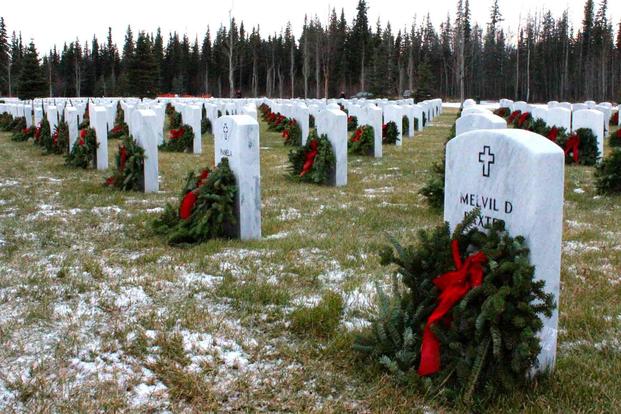Alaska has more veterans as a percentage of its population than any other state but has yet to land the funding it has been requesting to build its first veterans cemetery -- much to the frustration of some residents and Republican Sen. Dan Sullivan.
Sullivan vented over the Department of Veterans Affairs' repeated failure to grant the state's request for funding for its first-ever state-run veterans' cemetery during a Senate Veterans Affairs Committee hearing Feb. 28.
"The majority of the state, a state with more veterans per capita than any other state," Sullivan said during the hearing, "and we actually don't have a [state-run] veterans' cemetery. ... We keep missing the cutoff."
Veterans make up nearly 10% of Alaska's population, according to the U.S. Census, and yet it has been repeatedly passed over for VA cemetery funding, thanks in large part to a $220 million backlog of funding requests through the department's Veterans Cemetery Grants Program.
Since its inception in 1978, the grant program has provided nearly $1 billion in funding for the burial rites of veterans and their families. This includes establishing, expanding and maintaining 122 cemeteries across 49 states and Puerto Rico, with a prioritization for the expansion of existing cemeteries above all other projects.
"As currently planned, funding requested in the president's FY 2024 budget would be used to address cemetery expansions exclusively," Terrence Hayes, a VA spokesperson, told Military.com. "No funding would be available for new establishments."
The 18 proposals approved under fiscal 2024 funding are expansions that include three separate cemeteries in North Carolina and two in New Mexico. That means 51 grant proposals did not make the funding cut, 26 of which are older than five years.
The backlog of proposals would cost about $220 million to get through, Matthew Quinn, the under secretary for VA memorial affairs, said during the hearing.
"I understand that you want to help maintain the [cemeteries] you have," Sullivan told Quinn during the hearing. "That makes total sense. But it also makes total sense to help out the states that don't have anything yet."
The benefits of a state-run cemetery can include free burials, perpetual care, accessible facilities, and more room for veterans and their loved ones to be laid to rest together.
States can also follow different eligibility requirements than the national VA cemeteries, which were in the spotlight recently after finally offering the proper burial rites owed to 17 Black soldiers wrongfully convicted of mutiny and murder in the 1917 Houston Riot. The soldiers were awarded honorable discharges by the Army in 2023 and had their headstones updated to reflect the honors owed to them.
Alaska does have veterans cemeteries -- one on Joint Base Elmendorf-Richardson and the other within the state's only reservation, Metlakatla. But neither cemetery is state-run, and both are hard to access.
The veterans cemetery on Elmendorf-Richardson requires pre-approval to visit, which can be a time-consuming and logistical struggle for many families. The base cemetery is a madhouse over Memorial Day weekend, Sullivan said, and it can be just too challenging an endeavor for the families who want to visit but have no current military ties.
Metlakatla is home to a large population of Alaska Natives, who serve in the military at a higher rate than any other ethnic group in the country, and is located on southern Alaska's Annette Island, which is easier to get to from Vancouver, Canada, than the state's most-populated cities of Anchorage and Fairbanks.
Alaska has already purchased land necessary for a state-run cemetery, a step not covered through funding, but requisite to obtaining it. "It's a beautiful property," Sullivan said, but as the state keeps missing the cutoff for VA funding, the property continues to go unused.
Hayes confirmed to Military.com in an email that Alaska's application met all of the requirements needed for its proposal to be funded.
The state's proposal "would compete favorably with other requests to establish new cemeteries," Hayes said. "Cemeteries that serve veterans not currently served compete more favorably under current policy."
But prioritization still remains with pre-existing cemeteries, he added, seemingly leaving the state in limbo.
Despite the prioritization, Quinn promised to look into the Alaskan senator's request, as well as others expressed during the meeting, including inclement weather shelters for cemetery visitors in states such as Montana and North Dakota, and faulty flagpoles in Maine.
"We know we have just one chance to get it right, to honor veterans and their families for their service and sacrifice at their most vulnerable time," Quinn said.















